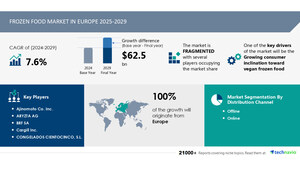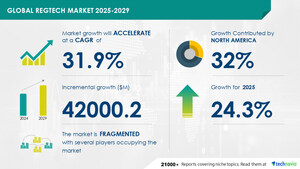NEW YORK, Oct. 1, 2024 /PRNewswire/ -- Report on how AI is driving market transformation - The Geothermal Power Market size is estimated to grow by USD 9.12 billion from 2024-2028, according to Technavio. The market is estimated to grow at a CAGR of about 21.1% during the forecast period. Rising investments and government initiatives in geothermal energy is driving market growth, with a trend towards rising geothermal capacity. However, high initial capital investments in establishing geothermal power plants poses a challenge - Key market players include Aboitiz Power Corp., Calpine Corp., Cyrq Energy Inc, DEEP Earth Energy Production Corp., Enel Spa, Energy Development Corp., EnergySource LLC, First Gen Corp, Geotherm Inc., Geothermal Engineering Ltd., HS Orka, Innergex Renewable Energy Inc., Kenya Electricity Generating Company PLC, KYUSHU ELECTRIC POWER CO., INC., NTPC Ltd., Ormat Technologies Inc., PT Pertamina Geothermal Energy Tbk, Reykjavik Geothermal, and Star Energy Geothermal.
Key insights into market evolution with AI-powered analysis. Explore trends, segmentation, and growth drivers- View the snapshot of this report
Geothermal Power Market Scope |
|
Report Coverage |
Details |
Base year |
2023 |
Historic period |
2018 - 2022 |
Forecast period |
2024-2028 |
Growth momentum & CAGR |
Accelerate at a CAGR of 21.1% |
Market growth 2024-2028 |
USD 9124.5 million |
Market structure |
Fragmented |
YoY growth 2022-2023 (%) |
18.8 |
Regional analysis |
APAC, North America, Europe, South America, and Middle East and Africa |
Performing market contribution |
APAC at 36% |
Key countries |
US, Indonesia, Philippines, New Zealand, and Turkey |
Key companies profiled |
Aboitiz Power Corp., Calpine Corp., Cyrq Energy Inc, DEEP Earth Energy Production Corp., Enel Spa, Energy Development Corp., EnergySource LLC, First Gen Corp, Geotherm Inc., Geothermal Engineering Ltd., HS Orka, Innergex Renewable Energy Inc., Kenya Electricity Generating Company PLC, KYUSHU ELECTRIC POWER CO., INC., NTPC Ltd., Ormat Technologies Inc., PT Pertamina Geothermal Energy Tbk, Reykjavik Geothermal, and Star Energy Geothermal |
The global geothermal power market is poised for significant growth due to the increasing demand for renewable energy sources and the abundance of geothermal resources in various countries. Japan International Cooperation Agency and Inter-American Development Bank, along with private and public players, are collaborating with nations like the Philippines, Kenya, Indonesia, and Chile to explore untapped geothermal energy resources. Technological advancements in drilling techniques and power plant efficiency, particularly Enhanced Geothermal Systems (EGS), are expanding geothermal power generation potential, lowering costs, and reducing exploration risks. These factors are expected to drive the expansion of existing geothermal power capacities worldwide, making geothermal energy a promising and attractive investment opportunity in the renewable energy sector.
Geothermal power is a renewable energy source derived from the Earth's core, providing thermal energy for heating and cooling and electricity generation. The market for geothermal power is trending due to its environmental benefits, including low atmospheric pollution and reduced greenhouse gas emissions (GHG). District heating systems using geothermal energy are gaining popularity, providing efficient heating and cooling solutions. Geothermal power generation comes with high capital costs due to drilling wells and production wells. However, the benefits of energy security and reduced dependence on fossil fuels make it an attractive option. Power plants use flash steam, dry steam, or binary cycle plants to convert thermal energy into electricity. Environmental concerns, such as carbon dioxide emissions, are being addressed through the development of cleaner geothermal energy projects. The Department of Defense is also investing in geothermal energy to power military bases and reduce electricity consumption. Geothermal energy projects face challenges from emission issues and the scarcity of high-temperature resources. Cash incentives and energy demand are driving the growth of geothermal power, making it a viable alternative to nuclear power and traditional electricity generation from fossil fuels. Electronic products and devices are also increasing the demand for clean energy, further boosting the market for geothermal power.
Request Sample of our comprehensive report now to stay ahead in the AI-driven market evolution!
• Geothermal power is an attractive renewable energy source due to its consistent and reliable energy output. However, the initial capital investments required to establish a geothermal power plant are substantial. These costs include exploratory drilling, well construction, and power plant design and construction. In the US, these expenses range from USD2,000 to USD3,000 per installed kilowatt (kW), with operating and maintenance costs averaging USD0.01 to USD0.05 per kilowatt-hour (kWh). The efficiency and reliability of geothermal power plants depend on the geothermal gradient and well depth. The cost of drilling a geothermal well increases with depth, accounting for 30%-70% of total capital investments. For example, a well with a depth of 1-3 kilometers requires USD2-USD8 million in capital investments per well. Maintenance costs also rise with increased turbine capacity, leading to higher electricity prices. Despite these challenges, the global geothermal power market is expected to grow, driven by government incentives and the need for sustainable energy solutions.
• Geothermal power is a renewable energy source derived from the Earth's core, providing thermal energy for heating and cooling applications, as well as electricity generation. District heating systems and power plants utilize high-temperature resources, such as flash steam and dry steam, to produce energy. However, challenges exist, including high capital costs and emission issues. Geothermal power generation contributes minimal greenhouse gas emissions, making it a clean energy alternative to fossil fuels and nuclear power. Despite these advantages, geothermal energy projects face hurdles, including the need for drilling wells to access geothermal reservoirs and the production of carbon dioxide emissions. Flash steam and dry steam plants are common energy generation technologies, while binary cycle plants and heat pumps offer alternative solutions. Government incentives, such as cash incentives and energy demand subsidies, can help offset high capital costs. As electronic product consumption grows, so does the need for reliable and sustainable energy sources. Geothermal power offers energy security and low atmospheric pollution, making it a valuable addition to the renewable energy mix. The Department of Defense is also exploring geothermal power's potential to support military bases and reduce reliance on fossil fuels.
Discover how AI is revolutionizing market trends- Get your access now!
This geothermal power market report extensively covers market segmentation by
- Type
- 1.1 Flash
- 1.2 Binary
- 1.3 Dry steam
- End-user
- 2.1 Industrial
- 2.2 Commercial
- 2.3 Residential
- Geography
- 3.1 APAC
- 3.2 North America
- 3.3 Europe
- 3.4 South America
- 3.5 Middle East and Africa
1.1 Flash- Geothermal flash power plants are a common and economical solution for generating electricity from geothermal resources. In these plants, geothermal fluid is pumped into a tank under high pressure, causing some of it to flash into steam. This steam drives a turbine connected to a generator, producing electricity. Single-flash and double-flash systems differ in the number of steam separators used. Single-flash plants use one separator, while double-flash systems use two. The latter system generates additional electricity by mixing high-pressure and low-pressure steam. Notable examples of double-flash power plants include Bouillante in Guadeloupe, Cerro Prieto in Mexico, and Hellisheidi in Iceland. Flash power plants offer cost advantages over binary and dry steam plants, with exploration, drilling, and field development costs amounting to 15-20% of total costs. With the increasing demand for affordable electricity, the flash power segment is expected to drive the growth of the global geothermal power market during the forecast period.
Download a Sample of our comprehensive report today to discover how AI-driven innovations are reshaping competitive dynamics
Geothermal power, derived from the Earth's core, is a renewable energy source that harnesses thermal energy for electricity generation. With fossil fuel scarcity and increasing focus on reducing greenhouse gas emissions, geothermal power has gained prominence as a clean energy alternative. Geothermal power generation, which includes flash steam and dry steam plants, offers low atmospheric pollution and is a reliable source of electricity. However, high capital costs and emission issues associated with certain geothermal power plants remain challenges. Cash incentives and energy demand continue to drive the growth of this renewable energy source. Geothermal power generation can significantly reduce carbon dioxide emissions compared to traditional fossil fuel-based electricity generation, making it an attractive option for environmental benefits. Despite the high capital costs, the long-term benefits of geothermal power make it a worthwhile investment for thermal energy production, particularly for electronic products and other energy-intensive industries.
Geothermal power, derived from the Earth's core, is a renewable energy source that offers numerous environmental benefits, including low atmospheric pollution and reduced greenhouse gas (GHG) emissions compared to fossil fuel-based energy sources. With the scarcity of fossil fuels and increasing energy demand, geothermal power generation has emerged as a viable alternative for electricity generation. Geothermal power plants use three main types of technology: flash steam, dry steam, and binary cycle. Flash steam plants generate electricity using high-pressure steam, while dry steam plants use dry, high-temperature steam. Binary cycle plants use a secondary fluid to generate electricity from thermal energy. Heat pumps are another application of geothermal power, used for heating and cooling. The Department of Defense and district heating systems are significant consumers of geothermal energy. Despite high capital costs and emission issues associated with flash steam and dry steam plants, geothermal power remains an attractive option for energy security and renewable energy production. Geothermal energy projects can provide thermal energy for heating, hot water, and electricity generation, and can also be used in the production of electronic products. However, drilling wells for production can be challenging and costly. Overall, geothermal power offers a clean, sustainable, and secure energy solution for a world increasingly reliant on electricity consumption and electronic devices.
1 Executive Summary
2 Market Landscape
3 Market Sizing
4 Historic Market Size
5 Five Forces Analysis
6 Market Segmentation
- Type
- Flash
- Binary
- Dry Steam
- End-user
- Industrial
- Commercial
- Residential
- Geography
- APAC
- North America
- Europe
- South America
- Middle East And Africa
7 Customer Landscape
8 Geographic Landscape
9 Drivers, Challenges, and Trends
10 Company Landscape
11 Company Analysis
12 Appendix
Technavio is a leading global technology research and advisory company. Their research and analysis focuses on emerging market trends and provides actionable insights to help businesses identify market opportunities and develop effective strategies to optimize their market positions.
With over 500 specialized analysts, Technavio's report library consists of more than 17,000 reports and counting, covering 800 technologies, spanning across 50 countries. Their client base consists of enterprises of all sizes, including more than 100 Fortune 500 companies. This growing client base relies on Technavio's comprehensive coverage, extensive research, and actionable market insights to identify opportunities in existing and potential markets and assess their competitive positions within changing market scenarios.
Technavio Research
Jesse Maida
Media & Marketing Executive
US: +1 844 364 1100
UK: +44 203 893 3200
Email: [email protected]
Website: www.technavio.com/
SOURCE Technavio

WANT YOUR COMPANY'S NEWS FEATURED ON PRNEWSWIRE.COM?
Newsrooms &
Influencers
Digital Media
Outlets
Journalists
Opted In





Share this article